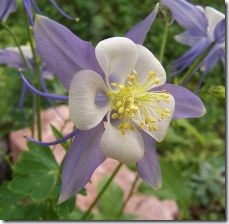Columbines are hardy perennial flowers native to Asia, Europe and America. The plant’s botanical name is Aquilegia vulgaris, which is derived from the Latin word aquila, meaning eagle. The flowers of the columbine plant are thought to resemble an eagle’s spurs. Columbine is Colorado’s state flower, and it thrives in the mountains and meadows there, splashing the countryside with its bright blue color.
History
-
Written accounts of columbine can be traced as far back as the 11th century, when the medicinal use of the plant was recorded in texts. The plant was believed to have aphrodisiac properties. In Tabernaemontanus’ New Herb Book, published in 1588, it was suggested that crushed columbine seeds be applied to a groom’s palms in order to arouse the bride. A tea made from the roots was believed to cure impotence, and infertility was abated by stuffing the plant into the mattress with the straw.
However, it wasn’t until the early 19th century that columbine gained popularity as a garden plant in Europe. The plant fell out of favor in formal gardens for a while, but it has become more popular in recent years and can still be found in many European and American decorative gardens.
Habitat
-
Columbines thrive in forests with rich soil, shade and ample moisture. They have been known to grow in full sun, but must have excessive moisture in order to survive. Columbine is easily grown in the home garden when optimal growing conditions are provided.
Wild columbine’s habitat has been threatened by increased encroachment on woodlands, which has led to its addition to Switzerland’s Red List of endangered plants. However, many cultivated varieties are available around the world.
Description
-
Columbine flowers have five spurred petals that are blue to bluish-white, and can reach up to 2 inches in diameter. Variations of pink, red and yellow flowers are also common. The plant may grow up to 2 feet high and 1 ½ feet wide, with bluish-green leaves growing on long stems. The deeply lobed leaves are divided into three parts and vaguely resemble clover leaves.
Uses
-
Columbines are most commonly used for decorative gardens and as cut flowers. They are particularly favored for shady borders, rock gardens and along paths and drives.
However, the plant also has been used medicinally for many centuries. In traditional folk medicine, columbine has been prescribed as an astringent for wounds, a kidney tonic, an impotence cure and a cancer preventative, and to treat headaches, nausea, upset stomach, diarrhea and rheumatism. While none of these treatments are supported by scientific evidence, they have been well-documented over the years.
Symbolism
-
Columbine was first dedicated to Freya, the Norse patron goddess of love and fertility. Much symbolism has been preserved in paintings and texts of medieval times that links the flower to sexuality, love, seduction and even infidelity. In the 17th century, it was considered highly inappropriate to give a young woman a bouquet of columbine, because of its sexual connotations.
As Christianity became more popular, the symbolism of columbine changed. It became associated with the Virgin Mary, and later with the core beliefs of Christianity, including faith, hope, charity, justice, temperance, prudence and fortitude. The flowers also were related to divinity in religious paintings portraying the Holy Spirit or Jesus.


Deprecated: strpos(): Passing null to parameter #1 ($haystack) of type string is deprecated in /home/agriviek8Qv/agriviet.net/public_html/wp-includes/comment-template.php on line 2522